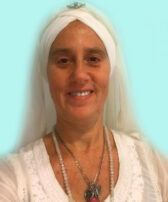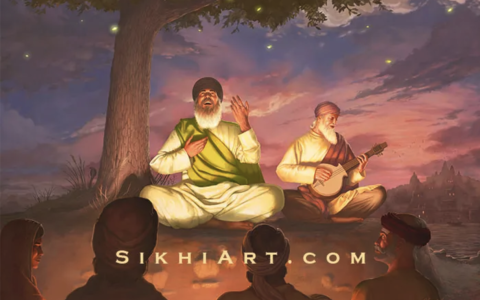by SS Atma Chanan Kaur Khalsa, Ph.D., Mendocino CA
2022 (Third Quarter)
A month ago, as I was driving away from the Española ashram towards California, I reflected on having taken my recent Minister vows. After two difficult years of a global pandemic, the many challenges of worldwide polarizations, and all the soul-searching from the shared stories of the early years of our Dharma, I wondered if I had made a mistake. I felt disconnected from my own Western values and everything I had learned thus far. Had I been selfish in thinking I was responding to a soul calling, and ignoring other people’s suffering? How do I stand in the face of oppression without bypassing complex psychological and social issues?
The spirit of the expansive lands of New Mexico reminded me of the lasting beauty of the heart, expressed in a poem by Rumi:
“[The vessel’s] lips give you to drink of the water of life. Truly it is the water, that which pours, and the One who drinks. All three become One when your talisman is shattered. That Oneness you can’t know by reasoning.”
As an academic, I always chose my pathways rationally, not depending on faith or ‘magical’ powers. However, in having an experience of Guru’s Grace— the one my soul had always known— I craved a deeper union with God. And that’s exactly what I got!
And yet, here I was again, questioning it All. I paused by the roadside, saddened by the shattered Oneness I experienced in the community. But it didn’t matter. No difficulty or tragedy could talk me out of my own self-knowing. As a gnostic, I had known that searching for one’s inner truth was a big part of the journey. In the rawness of my vulnerability, I let myself be One with the nurturing vessel of life that spoke back to me through the desert dunes and the Native American winds, announcing Indigenous wisdom hand-in-hand with the primal force of All Creation—Aykaa maa-ee jugat vi-aa-ee tin chalay parvan. [Nothing exists in the universe without the feminine principle of Divine Mother.] I was reminded of the ability to surrender—a feminine quality—to the Great Mystery. [1]
I imagined the pure light of Guru Nanak beaming through my windshield and my heart rejoiced with Sat Nam Wahe Guru. So much had changed since the day I took my vows—violence everywhere in a post-Covid era, the escalating war in Europe, and the increasing hate crimes and mass shootings in the USA. I remained hopeful that, while unveiling my own truth, I would welcome the light and the shadow of that Oneness that couldn’t be known by reasoning—Ohu vaykhai onaa nadar na aavai bahuta ayhu vidaan. [He watches over all, but none see Him.] And even when I was not sure what the “All” was truly about, I embraced more firmly than ever this “larger than us” unseen force that watches over us. Like Rumi’s vessel pouring water into my lips, the world’s belief systems and conditioning were breaking open for the liberation of all souls—not just mine—in an increasingly globalized and diverse planet.
Then I remembered that our Gurus were also tested by the tumultuous forces history presented to them. [2] Yet they never lost their faith in the One Creator—Ik sansaaree ik bhandaaree ik laa-ay deebaaan – and trusted equally the three deities, Creator, Sustainer and Destroyer. Humbly bowing —Aadays tisai aadays—they surrendered their sorrows and doubts to the Shabad Guru, thus finding comfort in their human condition amidst the wars and persecutions of the time.
In fact, a foundation of profound inclusion was built to address the existing quarrels over greed, land, and power. The Gurus confronted emperors and kings who imposed taxes on goods and territory, as well as those envious sons and brothers who carried out deceitful plans to overtake the Guruship. Against all obstacles and abuses, our Gurus’ faith became stronger. As crowds of seekers knocked on their doors for wisdom and clarity, no one was turned away. Jiv tis bhaavai tivai chalaavai jiv hovai furmaan [Everything and everyone aligned in Celestial Order.] Some received straight answers, while others were offered support, commitment, and acceptance. But most of all, everyone left with a full, open heart, having found their own unique truth—regardless of their position, caste, skin color, gender identity, sexual orientation, cultural or ethnic background.
Becoming an “ally” to those who have been at a disadvantage or have been historically oppressed and excluded (by war, religious ideology, deceit, slavery and abuse) is a belief at the very core of our Dharmic principles. Yet our community around the world is predominantly white and middle class, subject to colonial and hierarchical ways when it comes to authority and power. And today there continues to be a big gap between “us” and “the other,” for a multitude of reasons. In the West, the movement of our Dharma was conceived in the radical roots of the 1960s, but today we have settled into what is perhaps an insular worldview more intent on preserving “our” tradition than on asking important questions about inclusion and access to these teachings.
Perhaps many talismans need to be shattered—not just the assumption of Oneness—in order to bring attention to further disparities. As the complexity of being human has been unveiled in our differences as well as in the uniqueness of our polarities, the Gurus (and their partners) made space in their homes—and in the water tanks they built as sites of pilgrimage—and dared to be different! As we know, the Gurus themselves stood in defiance of the societal and ideological wars of the times as well as the emptiness of religious rituals. Nothing deceived their eyes, and certainly not the talisman of purity and righteousness. On the contrary, our Gurus called out injustices and flaws outside and within themselves, embracing forever the warriors’ true meaning of “Khalsa.” In defense of equity, diversity, and inclusion, they weren’t called “victims of trauma and circumstances” but warriors and saints.
As another state line approached, I saw the green sign, “Welcome to California,” and by Guru’s Grace, I took a deep breath. I was safe and sound, unshaken by the trauma of community politics and world events. I turned on the radio and heard about Juneteenth—a recently-approved USA holiday celebrating the end of slavery—a holiday that honors freedom for All. The radio host argued that this should be the nation’s holiday of independence, instead of the dreamy vision of “America” celebrated on July 4th. As an immigrant from Latin America, with both Indigenous and African blood, I agreed. And once again, I recalled Rumi’s poem: “One with the water, and One with that which pours, as well as One with the One who drinks.” That’s the Oneness beyond Maya, the one we recognize in all our hearts when we see and embrace “the other” in us and face the shadow of our collective Body.
The Generating, Organizing and Destroying forces—all three whispered to me at once on this road less traveled. A fleeting moment of happiness reminded me of my soul’s destiny in having taken my Minister vows in this ever-changing landscape of the world and of our Dharma.
Aadays tisai aadays. Aad aneel anaad anaahat jug jug ayko vays.
“I bow unto Him. I humbly bow. The Primal One, His Pure Light, without beginning, without end. Throughout all the ages, He is One and the Same.”
Notes:
- “Aykaa Maa-ee” is the 30th pauri of Guru Nanak’s Japji Sahib.
- The Sikh Religion, Vol. 1 – 6, 1909. Max Arthur MacAuliffe
Image Credit: “Guru Nanak Dev ji – Shabad Vichar” by Bhagat Singh Bedi. https://www.sikhiart.com/
ABOUT THE AUTHOR
 S.S. Atma Chanan Kaur has been a Minister of Sikh Dharma since May of 2021. She is a certified teacher of Kundalini Yoga and Meditation, and Chair of the Diversity, Equity, and Inclusion Committee at KRI. She has a Ph.D. in Sociology and a Certification in Collective Embodiment and Trauma. Atma Chanan Kaur was born and raised in Buenos Aires, Argentina, and has been active in social justice and human rights issues for Latina immigrant women, Indigenous and African Diasporic people since the 1990s, when she became a university professor and community organizer.
S.S. Atma Chanan Kaur has been a Minister of Sikh Dharma since May of 2021. She is a certified teacher of Kundalini Yoga and Meditation, and Chair of the Diversity, Equity, and Inclusion Committee at KRI. She has a Ph.D. in Sociology and a Certification in Collective Embodiment and Trauma. Atma Chanan Kaur was born and raised in Buenos Aires, Argentina, and has been active in social justice and human rights issues for Latina immigrant women, Indigenous and African Diasporic people since the 1990s, when she became a university professor and community organizer.


